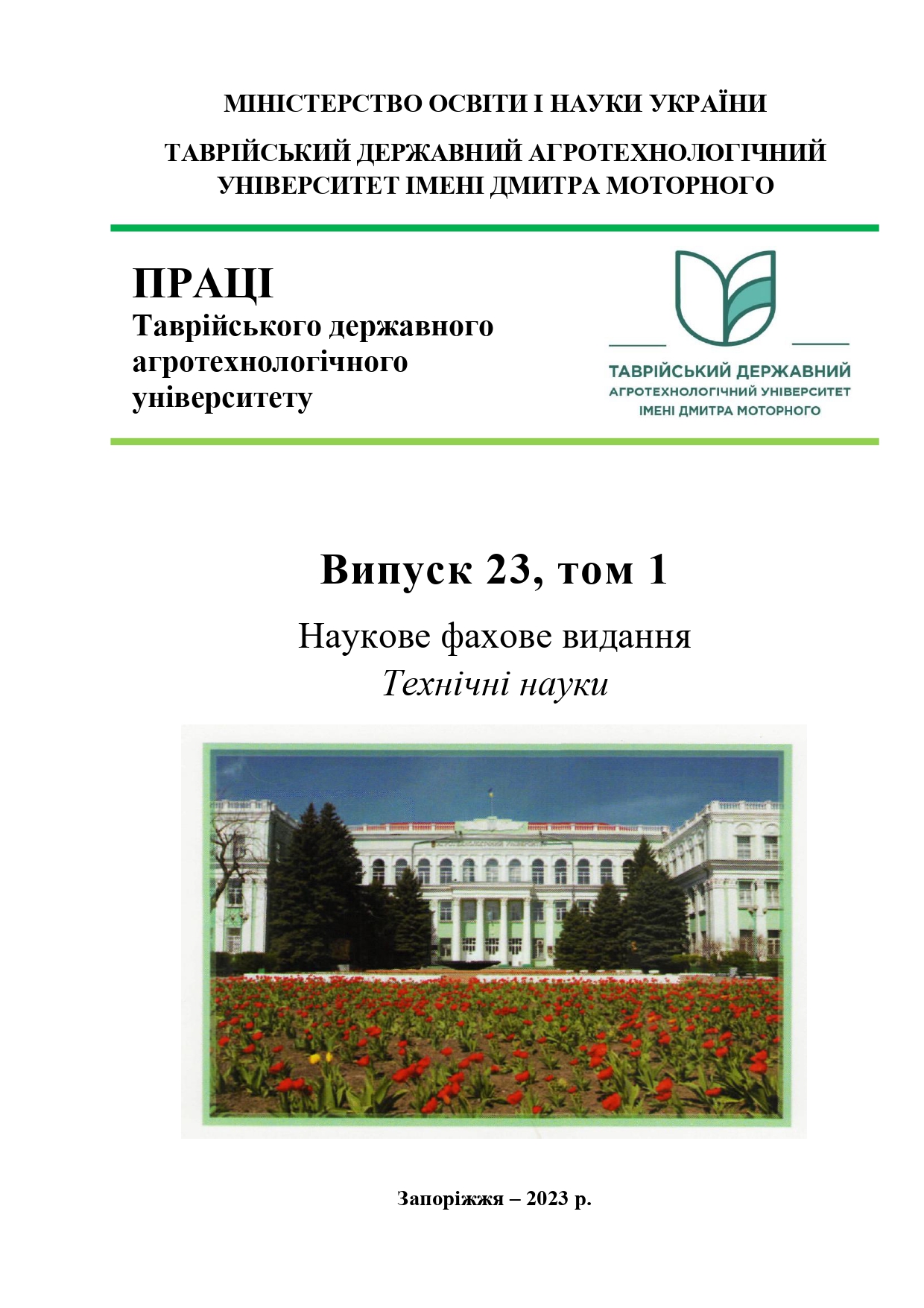МЕТОДИКА РОЗРАХУНКУ ПАРАМЕТРІВ ПРИСТРОЮ НА ОСНОВІ ІНЖЕКТОРА ВЕНТУРІ ДЛЯ ФЕРТИГАЦІЇ ПЛОДОВИХ НАСАДЖЕНЬ
Анотація
Анотація. Одним з найбільш розповсюдженим у застосуванні пристроєм для внесення добрив з поливною водою (фертигації) є інжектор Вентурі. Для розрахунку струминного апарату (насоса, ежектора, інжектора) необхідно визначити такі гідравлічні та геометричні параметри: 1) витрати робочої та всмоктуваної рідини; 2) питомі енергії (повні тиски) робочої, всмоктуваної та змішаної рідин; 3) площі зрізу робочого сопла або його діаметр, площу поперечного перерізу камери змішування або його діаметр. В статті наведено результати розробки спрощеної методики розрахунку пристрою фертигації, що використовує інжектор Вентурі в якості насосу для подачі маточного розчина добрив у поливну воду при зрошенні плодових насаджень. Побудовано характеристики інжектора у відносній формі для випадку, коли площа входу в камеру зміщення інжектора перевищує у два рази площу робочого сопла. Встановлено, що в такій конфігурації максимальне значення ККД інжектора досягається при відносній витраті q=0,6. При цьому відносний напір складатиме h=0,37, а коефіцієнт витрат робочого сопла р.с= 0,21. Наведено результати розрахунків витрати води через інжектор та об’єму інжекції залежно від геометричних параметрів інжектора та зміни тиску води.
Посилання
2. Куян В. Г. Плодівництво. Житомир: ЖНАЕУ, 2009. 480 с.
3. Кіщак О. А. Основи промислової культури черешні в Лісостепу України: монографія. Київ: Аграр. наука, 2017. 240 с.
4. Караєв О. Г., Одинцова В. А., Сушко С. Л. Формирование базы данных для автоматизированного управления физиологическим состоянием плодовых деревьев мелкодисперсным дождеванием. Motrol. Commision of Motorization and Energetics in Agriculture. 2016. Vol.18(1). P. 55–61.
5. Калачев В. В. Струйные насосы. Теория, расчет и проектирование. Mосква: Филинъ: “Омега-Л”, 2017. 418 с.
6. Лямаев Б. Ф. Гидроструйные насосы и установки. Ленинград: Машиностроение, 1988. 278 с.
7. Сазонов Ю. А., Деговцов А. В., Казакова Е. С., Клименко К. И. Многопоточный эжектор и новое направление для развития струйной техники. Территория НЕФТЕГАЗ. 2012. № 4. С. 75-77.
8. Сазонов Ю. А. Основы расчета и конструирования насосно-эжекторных установок. Москва: ГУП Изд-во «Нефть и газ» РГУ нефти и газа имени И.М. Губкина, 2012. 300 с.
9. Лямаев Б.Ф. Гидроструйные насосы и установки. Ленинград: Машиностроение, 1988. 256 с.
10. Альтшуль А. Д., Киселёв П. Г. Гидравлика и аэродинамика (основы механики жидкости). Москва: Стройиздат, 1965. 274 с.
11. Соколов Е. Я., Зингер Н. М. Струйные аппараты. Москва: Энергоатомиздат, 1989. 352 с.
12. Шатковський А. П., Журавльов О. В. Наукові основи технологій краплинного зрошення сільськогосподарських культур. Херсон: ВД Гельветика, 2021. 405 с.
13. Фоменко Т. Г., Попова В. П. Результаты мониторинга физико-химических свойств чернозема обыкновенного в плодовых насаждениях при капельном орошении. Научные труды ГНУ СКЗНИИСиВ. 2013. Т. 3. С. 42–49.
14. Фоменко Т. Г., Попова В. П. Формирование контуров увлажнения почвы при локальных малообъемных способах орошения плодовых насаждений. Мелиорация и водное хозяйство. 2016. № 4. С. 22–27.
15. Odyntsova V., Sushko S., Bondarenko L., Scherbakova N. Application of phenoclimatographic models in stone fruits protecting from spring frosts. Modern Development Paths of Agricultural Production. Trends and Innovations. 2019. Р. 267–280.
16. Aggelopoulou K. D., Pateras D., Fountas S., Gemtos T. A. Soil spatial variability and site-specific fertilization maps in an apple orchard. Precision Agriculture. 2011. Vol. 12 (1). P. 118–129.
17. Küçükyumuka C., Kaçal E., Ertek A., Öztürk G. at el. Pomological and vegetative changes during transition from flood irrigation to drip irrigation: Starkrimson Delicious apple variety. Scientia Horticulturae. 2012. T. 136. P. 17–23.
18. Fernández J. E., Cuevas M. V. Irrigation scheduling from stem diameter variations: A review. Agricultural and Forest Meteorology. 2011. Vol. 150. P. 135–151.
19. Friedman S. P., Naftaliev B. A survey of the aeration status of drip-irrigated orchards. Agricultural Water Management. 2012. Vol. 115. P. 132–147.
20. Kafkafi U., Tarchitzky J. Fertigation: A Tool for Efficient Fertilizer and Water Management. First edition, IFA, Paris, France and IPI, Horgen, Switzerland, 2011. 138 р.
21. Romashchenko M., Shatkowski A., Zhuravlev O. Features of application of the «Penman – Monteith» method for conditions of a drip irrigation of the Steppe of Ukraine (on example of grain corn). Journal of Water and Land Development. 2016. Vol. 31. P. 123–127. https://doi.org/10.1515/jwld-2016-0043.
22. Shatkovskyi A., Romashchenko M., Vasyuta V., Zhuravlov O. at el. Measurement of the cell sap concentration of plant’s leaves for irrigation’s scheduling. Modern Phytomorphology. 2019. Vol. 13. P. 54–57. https://doi.org/10.5281/zenodo.3518881.
23. Shatkovskyi A. P., Romashchenko M. I., Zhuravlov O. V., Vasyuta V. V. at el. Evaluation of the «Penman-Monteith» model for determination of soybeans’ evapotranspiration in irrigated conditions of the Steppe of Ukraine. Modern Phytomorphology. 2020. Vol. 14. P. 115–118. https://doi.org/10.5281/zenodo.4449887.
24. Hassan M. Badr, Wael H. Ahmed. Common Problems in Centrifugal Pumps. Pumping Machinery Theory and Practice. 2014. T. 5. https://doi.org/110.1002/9781118932094.
25. Kajero O. T., Thorpe R. B., Yao Yu., Wong D. S. H., Chen T.. Meta Model-Based Calibration and Sensitivity Studies of Computational Fluid Dynamics Simulation of Jet Pumps. Chemical engineering and technology. 2017. Vol. 4(9). P. 1674–1684. https://doi.org/10.1002/ceat.201600477.



